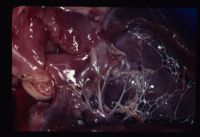Difference between revisions of "Degenerative Mitral Valve Disease"
| Line 52: | Line 52: | ||
==Treatment== | ==Treatment== | ||
| + | No treatment is recommended prior to the onset of heart failure. Treatment is aimed at managing congestive heart failure through a combination of drugs. | ||
| + | The aims of treatment are to: | ||
| + | #Reduce Preload | ||
| + | *Diuretics to reduce circulating fluid volume (Frusemide, Benzofluazide, Spironolactone, Amiloride) | ||
| + | *Vasodilators to reduce venous return (Nitrates, ACE inhibitors, Alpha antagonists) | ||
| + | #Reduce Afterload | ||
| + | *Vasodilators to decrease systemic vascular resistance | ||
| + | **ACE inhibitors e.g. Enalapril, Benzapril, Imidopril , | ||
| + | **Pimobendan | ||
| + | **Calcium channel blockers e.g. Amlodipine | ||
| + | **Nitrates e.g. Nitropusside | ||
| + | #Enhance Systolic function | ||
| + | *Positive Inotropes to increase cardiac contractility and increase cardiac output. | ||
| + | **Pimobendan | ||
| + | ** Digoxin | ||
| + | **Dobutamine | ||
| + | **Xanthines | ||
| + | #Improve Diastolic function | ||
| + | *Negative Chronotropes to increase the length of diastole (digoxin, atenolol) | ||
| + | *Calcium channel blockers to improve relaxation (amlodipine) | ||
| + | # Control cardiac arrhythmias using anti-arhythmic drugs | ||
| + | |||
==Prognosis== | ==Prognosis== | ||
==Literature Search== | ==Literature Search== | ||
Revision as of 19:35, 15 November 2010
| This article is still under construction. |
Also known as: MVD, Mitral insufficiency, Mitral endocardiosis, Myxomatous Mitral Valve Disease (MMVD)
- Common in dogs and cats
- Rare in other species
Signalment
Typically in middle aged to older small breed dogs. Genetically predisposed breeds include Cavalier King Charles Spaniel, Bull Terriers, German Shepherds, and Great Danes.
Introduction
A congenital malformation or degeneration of the mitral valve leaflets and its supporting structures(chordae tendineae, papillary muscles, valvular leaflets, annulus) results in valvular regurgitation (insufficiency)
Chronic mitral regurgitation leads to volume overload of the left heart, which results in dilatation (eccentric hypertrophy) of the left ventricle and atrium. When mitral regurgitation is severe, cardiac output decreases, which results in signs of left sided cardiac failure LCHF and pulmonary venous congestion. Dilatation of the left-sided chambers predisposes affected animals to arrhythmias. In some cases, malformation of the mitral valve complex causes a degree of valvular stenosis as well as insufficiency. In advanced cases, signs of right sided congestive heart failure may follow dur to an increased pressure load on the right ventricle as a result of long standing pulmonary congestion.
Diagnosis
History
- Exercise Intolerance
- Cough
- Dyspnoea
- Sudden death due to left atrial tear and pulmonary oedema
Clinical Signs
- Left apical Systollic Murmur
- Left sided Congestive heart failure
- Resting Tacchycardia
- Pale Mucous membranes
- Prolonged Capillary refill time (CRT)
- Prolonged Jugular filling time
- Pulmonary crackles / evidence of pulmonary oedema
- Cool extremities
- Loss of sinus arrhythmia
- Cardiac arrhythmias e.g. Atrial fibrilation, Atrial premature complexes
Diagnostic imaging
Radiography
- Cardiomegaly with dirsal displacement of the trachea
- Pulmonary Venous Congestion (Enlarged pulmonary Arteries and Veins)
- Pulmonary Oedema
Evidence of Right sided congestive heart failure maybe evident in severe cases e.g. distended caudal vena cava, hepatomegaly, ascites, pleural effusions.
Echocardiography
- Left Atrial enlargement
- Left Ventricular Enlargement
- Increased Fractional Shortening ( The % change in the left venticular diameter during systole used as a measure of systollic function)
- Malformed Valve leaflets
- Evidence of the regurgitant jet and turbulent flow in colour dopler
Electrocardiogram
- Enlarged Left Atrium (Wide P Wave)
- Enlarged Left Ventricle (Tall R wave, wide QRS complex, shift of mean electrical axis to the left)
Laboratory Tests
Treatment
No treatment is recommended prior to the onset of heart failure. Treatment is aimed at managing congestive heart failure through a combination of drugs. The aims of treatment are to:
- Reduce Preload
- Diuretics to reduce circulating fluid volume (Frusemide, Benzofluazide, Spironolactone, Amiloride)
- Vasodilators to reduce venous return (Nitrates, ACE inhibitors, Alpha antagonists)
- Reduce Afterload
- Vasodilators to decrease systemic vascular resistance
- ACE inhibitors e.g. Enalapril, Benzapril, Imidopril ,
- Pimobendan
- Calcium channel blockers e.g. Amlodipine
- Nitrates e.g. Nitropusside
- Enhance Systolic function
- Positive Inotropes to increase cardiac contractility and increase cardiac output.
- Pimobendan
- Digoxin
- Dobutamine
- Xanthines
- Improve Diastolic function
- Negative Chronotropes to increase the length of diastole (digoxin, atenolol)
- Calcium channel blockers to improve relaxation (amlodipine)
- Control cardiac arrhythmias using anti-arhythmic drugs
Prognosis
Literature Search
References
From Pathology
Often associated with mitral regurgitation and left atrial volume overload. Usually progresses to left sided heart failure.
Incidence:
- Most common congenital defect in cats.
- Also reported in pure breed dogs E.g GSD, Great Danes.
Clinical Signs:
- Often murmur is the only clinical sign; pansystolic with increased intensity over the mitral valve area.
- May also see exercise intolerance, dyspnoea and coughing.
Diagnosis:
- Left atrial enlargement on radiology and ECG.
- Doppler echocardiography can dtect abnormal flow.
Treatment:
- Prognosis poor, medically manage left heart failure with ACE-inhibitors etc.
